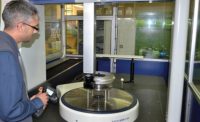Repeatable Leak Tests Boost Throughput
But Delta Faucet Co. (Indianapolis) has found a better way. The company, a major manufacturer of kitchen, lavatory and bathtub faucets and shower heads, was looking for a less subjective, more repeatable method of leak testing. Delta found what it was looking for in the Sentinel I-21, a pressure decay-based leak detection system supplied by Cincinnati Test Systems Inc. (Cleves, OH).
"We installed our first Cincinnati Test system about five years ago in our Jackson, TN, plant, and we've been adding more units each year since then as part of a continuous improvement process," says Terry Stephens, a Delta Faucet advanced manufacturing engineer.
The benefits are several. With traditional "air-underwater" testing, a machine operator must observe the number and the size of bubbles that emanate from a submersed product that leaks, an approach that is "subjective and hard to quantify," Stephens notes. The Cincinnati Test system, by contrast, relies on sensitive instrumentation to directly measure rate of air pressure loss. The system can detect changes as small as 0.000005 psi.
The result, according to Stephens, is that leak tests become highly accurate and repeatable. "All the testing that is done with this equipment is NIST traceable for ISO 9000 certification requirements," he says, "and the data can be stored and used later for process improvement."
Air-based pressure-decay testing is also more ergonomic and comfortable for operators than the underwater testing approach, which requires operators to get their hands wet, and to constantly lean over a tub to locate bubbles, Stephens says. Further, because the Sentinel system is automated and uses multiple test fixtures, test system throughput can be much higher than with conventional, water-testing methods, he adds.
Delta Faucet uses the pressure-decay systems to test a variety of products. In one Delta plant, for example, a single Sentinel system is used to test 33 different variations of tub and shower products. An operator keys in the part number to be tested, uses a master of that part to calibrate the machine and then begins the testing process.
The operator loads a part to be tested into a test fixture and activates the machine. Depending on the part, each test requires about 15 to 20 seconds. When the test is complete, the Sentinel system provides a numerical readout of the test result, and if the product passes the test, the system automatically unclamps the part. "As long as there are no rejects, the operator does nothing but load and unload the machine," Stephens says.
If a product fails the test, however, it remains clamped in the fixture, and the operator must touch another button to unclamp it, Stephens explains. "If a person is loading and unloading test equipment all day, there are times when the mind will wander," he observes. "So this is one way to make sure that operators don't make inadvertent errors."
Test cycle times for each product on the pressure-decay system are similar to those required for traditional air-underwater tests. But unlike the water-testing method, which requires the operator to observe the test from start to finish, the automated Sentinel system takes over once the product is loaded into the fixture. Consequently, as a way to make maximum use of an operator's time, "we've got two fixtures on one machine, so the operator can be loading a second part while the first one is testing," Stephens points out. The result, when compared to the air-underwater testing method, is that "throughput is drastically improved," Stephens says.
In all, Delta Faucet currently has five Sentinel systems deployed in its various U.S. and overseas plants, with additional units on order, says Stephens. "And we've even gone beyond that to supply two of our suppliers with pressure decay equipment, so that we get consistency from our suppliers that's repeatable," he says.
"It's not that our other test system was bad," Stephens concludes. "It's just that this system provides us with another step forward."
Cincinnati Test Systems Inc.
(513) 367-6699 Reply 10
www.cincinnati-test.com
BENEFITS
- Compared to traditional air-underwater leak testing methods, the automated, pressure-decay test system dramatically improves testing throughput.
- Leak test results are accurate and repeatable, and are NIST traceable to meet ISO certification requirements.
- Test data can be stored and used later for process improvement.
Looking for a reprint of this article?
From high-res PDFs to custom plaques, order your copy today!



